How to Use Parent and Child Rules
m (Pware moved page Parent and Child Rules to How to Use Parent and Child Rules: Renamed to fit guide lines for "How To" guides) |
m (→Trainz Wiki) |
||
| Line 230: | Line 230: | ||
*'''[[How to Use Track Triggers]]''' | *'''[[How to Use Track Triggers]]''' | ||
*'''[[How to Use Variables in Sessions (Examples)]]''' | *'''[[How to Use Variables in Sessions (Examples)]]''' | ||
| + | *'''[[Parent Rule List|List of Parent Rules]]''' | ||
*'''[[Message Popup Rule Applications]]''' | *'''[[Message Popup Rule Applications]]''' | ||
*'''[[Message Popup Example|Message Popup Rule Examples]]''' | *'''[[Message Popup Example|Message Popup Rule Examples]]''' | ||
*'''[[Navigation Point Applications]]''' | *'''[[Navigation Point Applications]]''' | ||
*'''[[Navigation Point Rules Examples]]''' | *'''[[Navigation Point Rules Examples]]''' | ||
| − | |||
</div> | </div> | ||
[[Category:How-to guides]] | [[Category:How-to guides]] | ||
Revision as of 22:33, 15 June 2018
Contents |
What Are Parent and Child Rules?
Most Parent Rules are used as "decision makers" in TANE Sessions. They decide if or when other rules, the Child Rules, will be executed. Some Parent Rules control how those Child Rules are executed.
| Rules that act as Parent Rules can have one or more sub-rules or Child Rules indented under them. |
- Only certain rules can be Parent Rules. See the Trainz Wiki page Parent Rule List for details.
- Most Parent Rules perform a test or a comparison and will return a true or false result, or will wait for a specific event.
| Rules that act as Child Rules are indented under a Parent Rule. |
- To indent a rule, highlight (select) it and click the Right Arrow Indent tool at the bottom of the Session Editor.
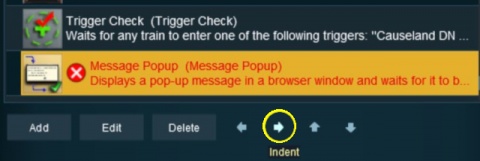 |
 |
- Any rule can be a Child Rule.
Example
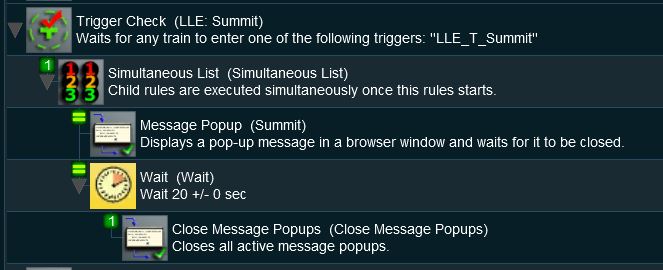 |
In the screenshot above, the
- Trigger Check Rule is a Parent Rule. It has rules indented below it.
- Simultaneous List Rule is indented under the Trigger Check Rule so it is a Child of that rule. It is also a Parent Rule as it has rules indented below it
- Message Popup Rule is indented under the Simultaneous List Rule so it is a Child of that rule.
- Wait Rule is indented under the Simultaneous List Rule so it is a Child of that rule. It is also a Parent Rule as it has rules indented below it
- Close Message Popup Rule is indented under the Wait Rule so it is a Child of that rule.
- Simultaneous List Rule is indented under the Trigger Check Rule so it is a Child of that rule. It is also a Parent Rule as it has rules indented below it
You can think of this as a family tree.
| Trigger Check Rule |
|
| Simultaneous Check Rule |
|
| Message Popup Rule |
|
| Wait Rule |
|
| Close Message Popup Rule |
|
Sequence of Events
- When the consist identified in the Trigger Check Rule, a Parent Rule, reaches the set trigger, the Trigger Event is activated and its Child Rules are executed.
- The Simultaneous List Rule, a Parent Rule, is then executed. It executes all its Child Rules immediately and simultaneously.
- The Message Popup Rule is executed. This waits until its message window is closed. At the same time ...
- The Wait Rule is executed. This is set to force a 20 second wait, after which its Child Rule ...
- The Close Message Popup Rule is executed. This closes the Message window created by the Message Popup Rule. Since it is the last rule under the Simultaneous List Rule it terminates that Parent Rule. Since it is the last rule under the Trigger Check Rule, it also terminates that Parent Rule.
- The Simultaneous List Rule, a Parent Rule, is then executed. It executes all its Child Rules immediately and simultaneously.
Ordered Lists vs Simultaneous Lists
The majority of sibling Child Rules, rules that are at the same indent level under a Parent Rule, will be executed in order (an Ordered List) or simultaneously (a Simultaneous List).
Ordered Lists
Rule details can be found at Ordered List Rule
| Ordered Lists are shown with numbered icons on each Child Rule which indicates the order in which they will be executed. |
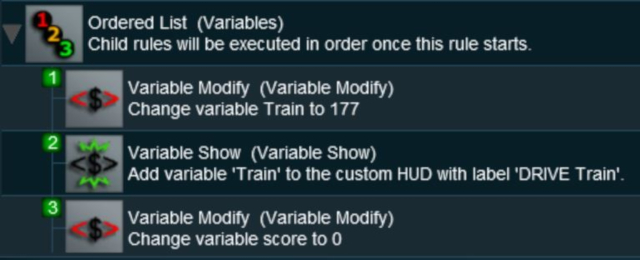 |
| Each Child Rule in the sequence must be completed before the next Child Rule can be executed. |
- Because some rules will wait for an event (such as a mouse click, timer, consist trigger, load trigger, etc) before they are completed, it is possible for the Ordered List to hang indefinitely waiting for the event.
- An Ordered List is completed when the last Child Rule is completed.
- If possible, place Child Rules that are event dependent at the end of an ordered list.
Simultaneous Lists
Rule details can be found at Simultaneous List Rule
| Simultaneous Lists are shown with equality ("=") icons on each Child Rule which indicates that they will be executed at the same time. |
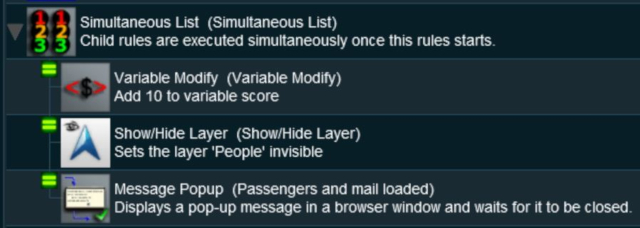 |
- A Simultaneous List can be set to complete when:-
- all the Child Rules are completed, OR
- any one of the Child Rules has been completed.
Other Types of Lists
Progressive Lists
Rule details can be found at Progressive List Rule
| On the first run of a Progressive List, only the first Child Rule is executed. On the second run, the second Child Rule is executed, on the third run the third Child Rule is executed, etc. |
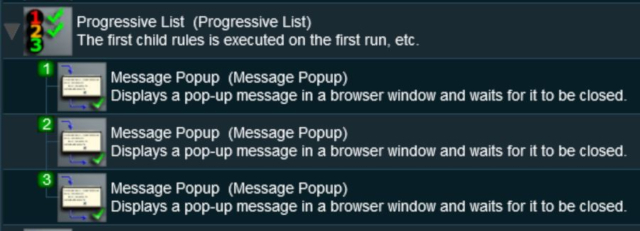 |
A Progressive List can be set to:-
- repeat the sequence after the last child rule has been executed, OR
- terminate (no further repeats) after the last child rule has been executed
Random Lists
Rule details can be found at Random List Rule
| A Random List will run ONLY ONCE and will randomly select a single Child Rule to execute. |
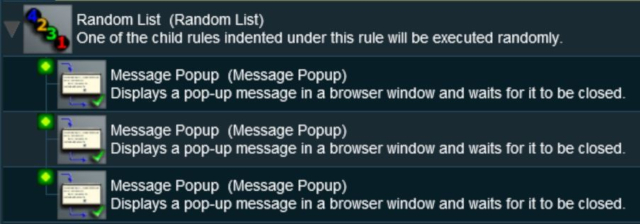 |
Reset Lists
Rule details can be found at Reset List Rule
| A Reset List will execute continuously, it will never terminate. Each time through the list all the Child Rules will be reset and executed again. |
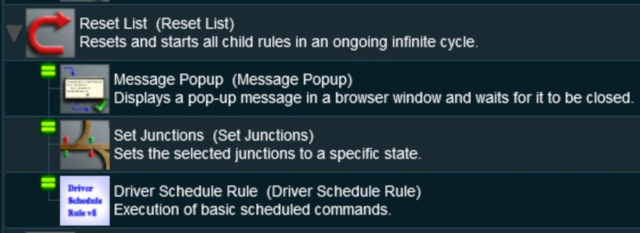 |
Trainz Wiki
- How to Guides
- Session Rules List (Alphabetical) with Parameters
- Session Rules List (Categories) With Parameters
Route Creation Tutorials:
Session Creation Tutorials:
- How to Create a HTML Asset
- How to Control Junctions in Sessions
- How to Control Signals in Sessions
- How to Use Track Triggers
- How to Use Variables in Sessions (Examples)
- List of Parent Rules
- Message Popup Rule Applications
- Message Popup Rule Examples
- Navigation Point Applications
- Navigation Point Rules Examples